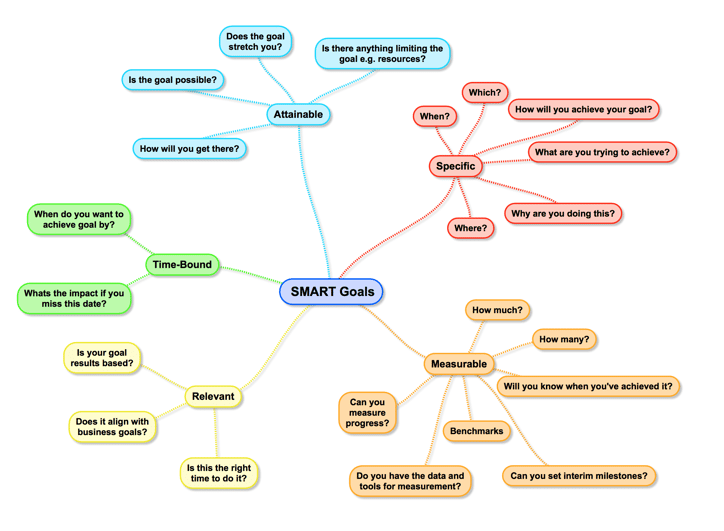One thing I have learned is that for a project to be successful, you need to think SMART when setting goals. Setting SMART objectives is the formula for all types of successful projects, whether it be marketing, sales, software development etc.
A SMART goal approach is an excellent framework for creating measurable and successful goals. By focusing on SMART goals for your marketing, you can plan and implement more successful activities and campaigns that can be easily aligned with your overall growth strategy.
SMART is an acronym that uses specific, measurable, achievable, realistic and timed objectives to formulate successful goals.
By examining each aspect of the SMART goal framework, you will better understand why SMART marketing goals set you up for success and how to incorporate them into your marketing plan.
So start by asking yourself or your team the following questions:
- Do you know what you are trying to achieve?
- Are your goals grounded and realistic?
- Do you have a way to measure progress and success?
- Do you have clear goals set to achieve the portion of overall business growth for which marketing will be held accountable?
- Do you have an effective plan to achieve this marketing proportion of the overall growth plan for your organisation? If not, why?
- Are your marketing goals aligned with your business goals?
If you hesitated on any of these or answered no, you need to consider SMART Marketing Goals. Your marketing efforts should be aligned with SMART goals if you want to succeed.
Download our FREE SMART Marketing Goals Template to help you determine your overall marketing goals.
What are SMART Goals?
Specific
When creating a goal, you want it to be as short and specific as possible. Having a goal like "grow website traffic" or "improve email marketing open rates" isn't specific enough. Instead, set goals like "increase leads generated by 10% by end Q2 2017", or "increase email open rates to 60% by end Q4 2017".
Measurable
When you set any goals, you need to be able to measure them. If you can't, how will you know how you have done? How can you measure success if you don't know what you are measuring against?
Take the example of "increase leads generated by 10% by end Q2 2024". This is a great goal as you know what your current lead generation volumes are, and so it is easy to calculate what an increase of 10% will be. You can use this to track month on month against your goal to keep on top of progress and tweak your tactics if it's not increasing quickly enough. At the end of Q2 2024, you will know straight away if you hit your goal or not.
Attainable
SMART goals need to be realistic and attainable. While it's admirable to shoot for the stars, it's not a good basis for goal setting, and you're unlikely to achieve these types of goals. So setting realistic goals is the best way forward. You can still try to beat them, but at least you are being realistic.
So for example, if you are currently generating 100 leads per month it's not realistic to set a goal of generating 500 leads by the end of next month (unless you have some marketing superpower that is). This is a 500% increase and is a goal you are unlikely to achieve. Setting unachievable goals can demotivate people who are tasked with trying to achieve them too so keep that in mind. SMART goals will encourage success and even over-achievement.
Relevant
There's no point in setting a goal that doesn't matter to your business or is one that it can't handle.
Say you have limited sales resources. Your goal of "increase leads generated by 10% by the end Q2 2024" won't make any difference to company growth if you don't have the salespeople to follow up with these additional leads. So why set that goal? In that particular case, it may be better to set a goal around converting more leads into customers so your existing salespeople can employ better tactics to achieve that goal, be more efficient, review their process etc. So make sure your goals are relevant, or they won't mean anything.
Time-Bound
A goal is not a goal if you don't set a date to achieve it. Without a date, you have nothing to work towards; there will be no sense of urgency, and it's unlikely that you will reach it. So be specific about when you want to accomplish your goal and start planning how you will actually achieve it.
I am a big fan of mind maps, so here's one that I use to help validate my SMART goals, which you may find useful when setting your own.

Examples of SMART Marketing Goals
So what does a good SMART marketing goal look like? Here are some good examples of inbound marketing SMART goals to inspire you:-
- Increase website visitors from 3,500 to 4,000 per month by the end Q4 2024
- Increase followers of our LinkedIn company page to 250 by the end of the 3d quarter in 2024.
- Increase blog subscribers by 10% by end Q3 2024.
- Generate 40 inbound marketing leads per month by 30 December 2024
- Hit a lead conversion ratio of 4.5% by the end of the second quarter, 2024.
- Hit an email open rate of 60% by September 30, 2024.
- Generate 30 customers from inbound marketing in 2024.
- Create a partnership with 5 media outlets to syndicate our blog content by September 31 2024
Setting SMART goals like these and breaking them into bite-size pieces will help you focus even more.
Take each goal, and plan your strategy, tactics, tasks and important milestones. Use the milestones as checkpoints to review how you are progressing and change tactics if you need to get better results in order to hit the final end goal.
If you don't have a marketing automation solution in place, you should consider getting one as it will enable you to track the results of all of your marketing efforts in one place and will increase overall productivity. Check out our "Reasons you Need to Automate your Marketing" post to read about all the benefits.
So here's a quick video recap of SMART Marketing Goals...
Summary
SMART goals keep you focused and increase your chances of success. They can be the difference between an effective strategy and one that fails.
SMART goals provide a clear and simple framework for defining and managing goals and objectives. They give you something tangible to work towards that can be easily monitored and measured. CMO's and Marketing Managers who set SMART goals are more likely to see much better results from their marketing projects and campaigns. They can lead their teams with greater effectiveness while continually motivating team members.
Clear priorities, structure, consistency, transparency, better resource management, motivation and accountability will become part of the culture. Success will become much more frequent, and you will be able to prove to senior management exactly how much you contribute to the company's overall growth.
But remember, don't just set SMART marketing goals, make sure you put a detailed plan in place to help you achieve them.
To help you get started, download our marketing goals template below to help you determine what your SMART goals should be for common elements such as visitors, leads, customers, conversion rates etc. An essential tool for setting your SMART goals.
If you would like to discuss your marketing goals or need any advice on making them SMART and aligning them to your business goals, feel free to contact us.




